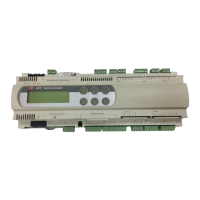Il valore di pressione “Ps” che la sonda sta inviando è così ricavabile
(FS = Fondo Scala):
Ps = (Vmis/50 - 0,004) x (FSmax - FSmin) / 0,016 + Fsmin
Esempio: la sonda impiegata ha Fsmin = -0,5 bar, Fsmax = 7 bar;
la tensione letta è pari a Vmis= 0,5 Vdc.
La pressione Ps che la sonda sta misurando vale:
Ps = (0,5/50 - 0,004) x [7 - (-0,5)] / 0,016 + (-0,5) = 2,3 bar
• Verificare che il capillare sonda non sia ostruito.
Sonde NTC
: il segnale sonda è un valore resistivo che dipende dalla
temperatura.
Qui sotto sono riportati alcuni valori di resistenza a diverse
temperature. Scollegando la sonda dall’ingresso dell’interfaccia e
misurando con un multimetro la sua resistenza, dopo aver confrontato
la tabella si può avere il valore di temperatura corrispondente.
°C kΩ °C kΩ °C kΩ
-20 67,71 0 27,28 20 12,09
-15 53,39 5 22,05 25 10,00
-10 42,25 17 17,96 30 8,31
-5 33,89 15 14,68 35 6,94
Misurando con un voltmetro la tensione presente ai capi dei morsetti
Bn ed GND, con inserito un NTC, si deve misurare una tensione pari a:
Vin= 4,2 x Rp / (10000+Rp) , dove Rp è la resistenza espressa in ohm
del parallelo tra la resistenza dell’NTC e 100.000 Ω.
Esempio: inserendo una resistenza da 10 K in ingresso (che
corrisponde a 25 °C) si ha che Rp= 10//100 KΩ= 9090 Ω;Vin= 4,2 x
9090/19090= 2V
P
er verificare l’impostazione degli ingressi sonde
Spegnere il pCO
2
e fare le seguenti misure con un tester tra l’ingresso
sonda Bn ed GND:
Negli ingressi B1, B2, B3, B6, B7 e B8 si misura una resistenza di
circa 50 KΩ
Negli ingressi B4, B5, B9 e B10 si misura una resistenza di circa 10 kΩ
Poiché il pCO
2
ha l’impostazione del tipo di ingresso analogico
effettuata via software, se l’applicativo lo prevede, una verifica più
corretta può essere eseguita sconnettendo i sensori e alimentando il
pCO
2
.Misurare:
tipo sonda Tensione misurata
NTC 3,8 V
4/20mA 0 V
PT1000 3,8 V
0/1V o 0/10 V 0 V
Dubbia segnalazione di allarme da ingresso digitale
Verificare:
1. se è presente il segnale di allarme all’ingresso, misurando la
tensione tra il morsetto comune “IDCM1 e IDCM2” e il morsetto
dell’ingresso digitale indicante l’allarme “IDn”:
• se si ha tensione (24 Vac o 24 Vdc a seconda dell’alimentazione
utilizzata per gli ingressi digitali) il contatto del dispositivo di
allarme collegato è chiuso;
• se la tensione è minore di circa 10 Vac o 10 Vdc (vedi sopra) il
contatto è aperto.
Se non espressamente dichiarato altrimenti, il controllo dà allarme
quando rileva contatti aperti.
The pressure value “Ps” sent by the probe can be calculated as
follows (FS=Full Scale):
Ps = (Vread/50 - 0.004) x (FSmax - FSmin) / 0.016 + Fsmin
Example: the probe used has a FSmin=-0.5bar, FSmax=7bar;
the voltage read is Vread= 0.5Vdc.
The pressure Ps that the probe is measuring is thus:
Ps = (0.5/50 - 0.004) x [7 - (-0.5)] / 0.016 + (-0.5)=2.3bar
• Check that the probe capillary is not blocked.
NTC probes
:the probe signal is a resistive value which depends
on the temperature.
The table below lists some of the resistance values for different
temperatures.On disconnecting the probe from the interface input and
measuring, using a multimeter, its resistance, the following table can be
used to calculate the corresponding temperature value.
°C kΩ °C kΩ °C kΩ
-20 67,71 0 27,28 20 12,09
-15 53,39 5 22,05 25 10,00
-10 42,25 17 17,96 30 8,31
-5 33,89 15 14,68 35 6,94
When measuring the voltage, using a voltmeter, at the terminals Bn
and GND, with an NTC inserted, the voltage must be:
Vin= 4.2 x Rp / (10000+Rp), where Rp is the resistance in ohms in
parallel between the resistor of the NTC and 100,000 Ω.
Example: fitting a 10K resistor to the input (this corresponds to 25°C),
Rp= 10//100 KΩ= 9090 Ω;Vin= 4.2 x 9090/19090= 2V
T
o check the settings of the probe inputs
Tu rn off the pCO
2
and perform the following measurements using a
tester between probe input Bn and GND:
The resistance measured for inputs B1, B2, B3, B6, B7 and B8 is
around 50KΩ
The resistance measured for inputs B4, B5, B9 and B10 is around
10KΩ
As the type of analogue input on the pCO
2
is set by software, if the
application allows, a more correct check can be carried out by
disconnecting the sensors and powering the pCO
2
.Measure:
Probe type Voltage measured
NTC 3.8 V
4/20mA 0 V
PT1000 3.8 V
0/1V or 0/10 V 0V
Unusual alarm signal from the digital input
Check:
1. if the alarm signal is present at the input, measure the voltage
between the common terminal “IDCM1 and IDCM2” and digital input
terminal which indicates the alarm, “IDn”:
• if voltage is present (24 Vac or 24 Vdc depending on the power
used for the digital inputs) the contact of the connected alarm
device is closed;
• if the voltage is 10Vac or 10Vdc (see above) the contact is open.
If not expressly stated otherwise, the control creates an alarm
when it detects open contacts.
60
pCO
2
- cod. +030221835 rel. 3.0 - 18.02.03

